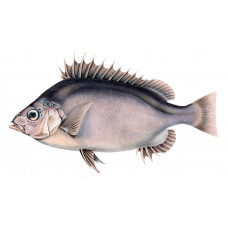Latin name
Pentaceros richardsoni
Other names
Richardson's boarfish, southern boarfish
Identification
Body elongated, rather tall, strongly compressed at the sides, covered with fine ctenoid scales. The body height is about three times the standard body length. Head moderately long (29-36% of standard body length), covered with coarse bones, striated with transverse bands. The profile of the snout is straight, but in large individuals the end of the snout is rounded and bulbous. Eyes of moderate size, their diameter 3.1-4.2 times less than the length of the head. The mouth is small, slightly slanting. The teeth on both jaws are very short, slightly curved, arranged in narrow rows tapering to the sides of the jaws. There are teeth on the coulter. The first gill arch has 20-23 gill stamens, with 5-7 stamens on the upper part of the arch and 14-15 stamens on the lower part of the arch. The caudal stem is short. The lateral line curves upward above the pectoral fins, follows the upper profile of the body, then descends gently and runs along the centre of the caudal peduncle; it has 70-89 scales. There are 26 vertebrae.
Features of fish fins
The dorsal fin has 14-15 hard rays and 8-9 soft rays. The base of the hard rays is much longer than the base of the soft rays. The fourth barb is the tallest. The last barb is shorter than the soft rays. The anal fin has 4-5 barb rays and 7-8 soft rays. The barb rays of the dorsal fin are directed in different directions and may retract into a groove; the second barb ray is the longest. Pectoral fins are long, island-like, with 17-18 soft rays; the upper rays are much longer than the lower ones. Behind the pectoral fins are large pelvic fins, with one strong barb and 5 soft rays. Caudal fin with a small notch.
Fish colouring
Most of the adult body is a shimmering dark steel blue. The underparts and belly are silvery-grey to grey-green. Pectoral and caudal fins are dark, pelvic fins are pale. The upper body of juveniles has pale lines and blotches.
Distribution
Widespread in the temperate waters of all Southern Hemisphere oceans. Pacific Ocean: Southern Australia, New Zealand, southern tip of South America (to Cape Horn). Indian Ocean: east coast of South Africa. Atlantic Ocean: Whale Ridge, Western Cape Province, Tristan da Cunha Islands.
Habitat
Marine benthic fishes. They live above the outer edge of the shelf and continental slope at depths of up to 1000 m. They are often found near seamounts, ridges and uplands.
Size
Adults reach 30-35 centimetres in length and weigh almost a kilogram.
Behavior
Adults prefer deep water, while juveniles can be seen close to the surface.
Food and feeding habits
Their diet includes tunicates, ctenophores, jellyfish and shrimps.
Reproduction
They spawn in winter.
Fishing
Commercial fishing. Fished by demersal and pelagic trawls. The flesh has high flavour qualities.
| Classification | |
| Phylum | Chordata |
| Class | Actinopterygii |
| Squad | Perciformes |
| Family | Pentacerotidae |
| Genus | Pentaceros |
| Species | P. richardsoni |
| Features | |
| Conservation status | No information |
| Habitat | Pelagic |
| Life span, years | No information |
| Maximum body weight, kg | 1 |
| Maximum length, cm | 35 |
| Sailing speed, m/s | No information |
| Threat to people | Edible |
| Way of eating | Not a predator |
Pelagic armourhead
Tags: pelagic armourhead

